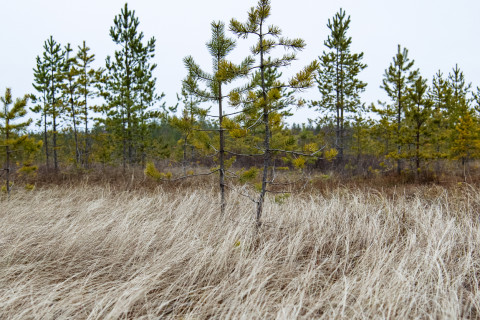The doctoral dissertation in the field of Forestry will be examined at the Faculty of Science, Forestry and Technology, Joensuu Campus.
What is the topic of your doctoral research? Why is it important to study the topic?
The topic of my doctoral research is the impact of mechanical soil disturbance, specifically caused by thinning operations in drained boreal peatland forests. This research focuses on understanding how these disturbances affect peat soil properties and soil biochemistry in these unique ecosystems.
Studying this topic is of paramount importance for several reasons. First and foremost, boreal peatland forests are a vital source of timber, making them economically significant. In recent times, there has been an extension of timber harvesting into warmer months, leading to increased machinery traffic over unfrozen soils. This shift in harvesting practices has resulted in higher levels of soil disturbance, including the formation of deeper ruts. Given the economic importance of timber harvesting in these ecosystems, it is essential to assess and understand the potential impacts of these disturbances on the peatland environment.
Moreover, boreal peatland forests play a critical role in carbon storage and climate change mitigation. They are among the largest terrestrial carbon stores globally. As such, any disturbance to these ecosystems has the potential to release stored carbon into the atmosphere, contributing to greenhouse gas emissions and climate change. Understanding the effects of mechanical soil disturbance on peat soil properties and biochemistry is crucial for assessing the carbon sequestration potential of these forests and developing strategies to minimize carbon emissions during timber harvesting operations.
Furthermore, the knowledge gap mentioned in the question is significant. Despite the increased soil disturbance resulting from extended timber harvesting seasons, our understanding of how these disturbances impact peat physical properties and soil biochemistry remains limited. Closing this knowledge gap is essential for making informed decisions about forest management practices in boreal peatland ecosystems. It allows for the development of sustainable forestry practices that balance the economic benefits of timber harvesting with the need to protect and conserve these ecologically valuable carbon-rich ecosystems.
In summary, my doctoral research topic focuses on the impact of mechanical soil disturbance in drained boreal peatland forests. Studying this topic is crucial due to the economic significance of timber harvesting, the role of these ecosystems in carbon storage, and the need to address the knowledge gap surrounding the effects of soil disturbance in these unique environments.
What are the key findings or observations of your doctoral research?
The key findings and observations of my doctoral research revolve around the sensitivity and resilience of drained boreal peatlands to mechanical soil disturbance caused by thinning operations. The study demonstrated that these peatlands are indeed sensitive to disturbance, but they also exhibit a surprising degree of resilience to such mechanical soil disturbance. One of the most significant findings is that thinning operations, which involve the selective removal of trees in a forest, do not lead to permanent changes in peat soil properties. This suggests that these peat soils have the capacity to recover and adapt to the disturbances caused by forest machinery.
This finding is particularly valuable and interesting for both the general public and the scientific community for several reasons. Firstly, it provides a sense of reassurance for forest management practices in boreal peatland ecosystems. Knowing that thinning operations do not result in lasting damage to peat soil properties can inform sustainable forest management strategies, ensuring the conservation of these vital ecosystems. Secondly, this research highlights the resilience of peatlands, which are crucial carbon storage ecosystems. Boreal peatlands store significant amounts of carbon, and understanding their resilience to disturbance is essential in the context of climate change mitigation and carbon sequestration efforts.
Finally, the study emphasizes the need for caution and responsible land management. While initial thinnings were found to have limited long-term consequences on soil properties, it is important to note that the study solely examined these initial disturbances. Frequent or severe disturbances may still have more significant and lasting impacts on drained peatland ecosystems. This serves as a reminder to the scientific community and policymakers that sustainable land management practices should be upheld to preserve the resilience of these ecosystems in the face of potential future challenges.
In summary, my doctoral research's key findings demonstrate the sensitivity and resilience of drained boreal peatlands to mechanical soil disturbance caused by thinning operations. The novelty and value of these findings lie in their implications for sustainable forest management, carbon sequestration, and the importance of responsible land use practices in the context of these critical ecosystems.
How can the results of your doctoral research be utilised in practice?
The results of my doctoral research have practical implications that can be utilized in several important ways: Assessing the Impact of Forest Machinery Traffic: The findings of this study provide valuable insights into the impact of forest machinery traffic on peat soils in boreal peatland forests. These insights can be applied to assess the level of soil disturbance caused by different machinery and harvesting practices. Forest managers and policymakers can use this information to make informed decisions regarding the choice of equipment and operational practices to minimize soil disturbance during timber harvesting operations. Promoting Sustainability in Peatland Forestry: Sustainable forestry practices are essential to balance economic interests with environmental conservation. The research highlights that initial thinning operations in boreal peatlands may not lead to permanent changes in peat soil properties. This knowledge can guide sustainable forestry practices, allowing for timber harvesting while maintaining the long-term health and resilience of peatland ecosystems. It emphasizes the importance of managing these ecosystems in a way that minimizes carbon emissions and protects their ecological value. Establishing Thresholds for Soil Disturbance: Understanding the threshold of soil disturbance beyond which restorative actions should be taken is critical.
The research suggests that while initial thinning operations are relatively resilient, frequent or severe disturbances may have more significant long-term consequences on peat soil properties. This information can help establish guidelines and thresholds for soil disturbance levels, enabling forest managers to identify when restorative actions, such as soil stabilization or reclamation, are necessary to reduce physical and biological damage to peatland soils. In summary, the results of my doctoral research can be practically applied to evaluate the impact of forest machinery traffic on peat soils, promote sustainability in peatland forestry practices, and establish thresholds for soil disturbance that trigger restorative actions. By implementing these insights, forest management can become more environmentally responsible and economically sustainable while preserving the unique and valuable characteristics of boreal peatland ecosystems.
What are the key research methods and materials used in your doctoral research?
Throughout the research process, a multifaceted approach was employed, encompassing various methods to comprehensively assess the impact of mechanical soil disturbance on drained boreal peatland ecosystems. Physical methods involved soil property measurements and compaction assessments, biological methods delved into the soil microbial responses, greenhouse gas studies examined gas concentrations and emissions, while vegetation methods included surveys, and biomass measurements. The integration of these diverse techniques allowed for a holistic understanding of the complex dynamics within these ecosystems, aiding in the development of sustainable forestry practices and the conservation of these invaluable environments.
For more information, please contact:
Dmitrii Lepilin, [email protected]






